Development of Zn–Mg–Ca Biodegradable Dual-Phase Alloys
Abstract
1. Introduction
2. Materials and Methods
3. Results and Discussion
3.1. Microstructure and Degradation Behavior of Zn–Mg–Ca Dual-Phase Alloys
- (i)
- Galvanic corrosion selectively causes anodic dissolution in the second phase, which is accompanied by active hydrogen evolution as a cathodic reaction in the nearby matrix phase, primarily by the following reactions.
- (ii)
- Some hydrogen atoms penetrate the matrix phase and rejoin on a molecular level below the surface. This generates hydrogen gas within the matrix phase and produces a swelling called a blister [38].
- (iii)
- At some point, the blisters rupture, causing cracks.
- (iv)
- The cracks may induce fracture of the alloy.
3.2. Variation in Galvanic Corrosion Behavior between IM3 and IM1 Phases Depending on IM1 Phase Composition and Area Fraction
3.3. Actual Control of Degradation Behavior of IM3/IM1 Dual-Phase Alloys
4. Conclusions
Supplementary Materials
Author Contributions
Funding
Data Availability Statement
Conflicts of Interest
References
- Niinomi, M. Recent metallic materials for biomedical applications. Metall. Mater. Trans. A 2002, 33, 477–486. [Google Scholar] [CrossRef]
- Liu, Y.; Zheng, Y.; Chen, X.-H.; Yang, J.-A.; Pan, H.; Chen, D.; Wang, L.; Zhang, J.; Zhu, D.; Wu, S.; et al. Fundamental theory of biodegradable metals—Definition, criteria, and design. Adv. Func. Mater. 2019, 29, 1805402. [Google Scholar] [CrossRef]
- Witte, F.; Fischer, J.; Nellesen, J.; Crostack, H.A.; Kaese, V.; Pisch, A.; Beckmann, F.; Windhagen, H. In vitro and in vivo corrosion measurements of magnesium alloys. Biomaterials 2006, 27, 1013–1018. [Google Scholar] [CrossRef] [PubMed]
- Staiger, M.P.; Pietak, A.M.; Huadmai, J.; Dias, G. Magnesium and its alloys as orthopedic biomaterials: A review. Biomaterials 2006, 27, 1728–1734. [Google Scholar] [CrossRef] [PubMed]
- Kannan, M.B.; Raman, R.K.S. In vitro degradation and mechanical integrity of calcium-containing magnesium alloys in modified-simulated body fluid. Biomaterials 2008, 29, 2306–2314. [Google Scholar] [CrossRef]
- Gu, X.; Zheng, Y.; Cheng, Y.; Zhong, S.; Xi, T. In vitro corrosion and biocompatibility of binary magnesium alloys. Biomaterials 2009, 30, 484–498. [Google Scholar] [CrossRef] [PubMed]
- Zhang, S.; Zhang, X.; Zhao, C.; Li, J.; Song, Y.; Xie, C.; Tao, H.; Zhang, Y.; He, Y.; Jiang, Y.; et al. Research on an Mg-Zn alloy as a degradable biomaterial. Acta Biomater. 2010, 6, 626–640. [Google Scholar] [CrossRef] [PubMed]
- Zhen, Z.; Xi, T.-F.; Zheng, Y.-F. A review on in vitro corrosion performance test of biodegradable metallic materials. Trans. Nonferr. Met. Soc. China 2013, 23, 2283–2293. [Google Scholar] [CrossRef]
- Hagihara, K.; Ohkubo, M.; Yamasaki, M.; Nakano, T. Crystal-orientation-dependent corrosion behaviour of single crystals of a pure Mg and Mg-Al and Mg-Cu solid solutions. Corr. Sci. 2016, 109, 68–85. [Google Scholar] [CrossRef]
- Shuai, C.; Li, S.; Peng, S.; Feng, P.; Lai, Y.; Gao, C. Biodegradable metallic bone implants. Mater. Chem. Front. 2019, 3, 544–562. [Google Scholar] [CrossRef]
- Han, H.-S.; Jun, I.; Seok, H.-K.; Lee, K.-S.; Lee, K.; Witte, F.; Mantovani, D.; Kim, Y.-C.; Glyn-Jones, S.; Edwards, J.R. Biodegradable magnesium alloys promote angio-osteogenesis to enhance bone repair. Adv. Sci. 2020, 7, 200800. [Google Scholar] [CrossRef]
- Tsakiris, V.; Tardei, C.; Clicinschi, F.M. Biodegradable Mg alloys for orthopedic implants—A review. J. Mag. Alloys 2021, 9, 1884–1905. [Google Scholar] [CrossRef]
- Zberg, B.; Uggowitzer, P.J.; Löffler, L.F. MgZnCa glasses without clinically observable hydrogen evolution for biodegradable implants. Nat. Mater. 2009, 8, 887–891. [Google Scholar] [CrossRef] [PubMed]
- Hagihara, K.; Shakudo, S.; Fujii, K.; Nakano, T. Degradation behavior of Ca-Mg-Zn intermetallic compounds for use as biodegradable implant materials. Mater. Sci. Eng. C 2014, 44, 285–292. [Google Scholar] [CrossRef] [PubMed]
- Cao, J.D.; Weber, T.; Schäublin, R.; Löffler, J.F. Equilibrium ternary intermetallic phase in the Mg-Zn-Ca system. J. Mater. Res. 2016, 31, 2147–2155. [Google Scholar] [CrossRef]
- Lin, G.; Liu, D.; Chen, M.; You, C.; Li, Z.; Wang, Y.; Li, W. Preparation and characterization of biodegradable Mg-Zn-Ca/MgO nanocomposites for biomedical applications. Mater. Charact. 2018, 144, 120–130. [Google Scholar] [CrossRef]
- Babilas, R.; Bajorek, A.; Włodarczyk, P.; Łoński, W.; Szyba, D.; Babilas, D. Effect of Au addition on the corrosion activity of Ca-Mg-Zn bulk metallic glasses in Ringer’s solution. Mater. Chem. Phys. 2019, 226, 51–58. [Google Scholar] [CrossRef]
- Schäublin, R.E.; Becker, M.; Cihova, M.; Gerstl, S.S.A.; Deiana, D.; Hébert, C.; Pogatscher, S.; Uggowitzer, P.J.; Löffler, J.F. Precipitation in lean Mg-Zn-Ca alloys. Acta Mater. 2022, 239, 118223. [Google Scholar] [CrossRef]
- Wang, Y.; Zhang, L.; Chen, B.; Bo, W.; Zhou, Y.; Geng, G. Effect of Zn on glass-forming capacity and corrosion resistance of Ca-based amorphous alloys. J. Non-Cryst. Solids 2022, 591, 121713. [Google Scholar] [CrossRef]
- Fu, J.; Du, W.; Liu, K.; Du, X.; Zhao, C.; Liang, H.; Mansoor, A.; Li, S.; Wang, Z. Effect of the Ca2Mg6Zn3 phase on the corrosion behavior of biodegradable Mg-4.0Zn-0.2Mn-xCa alloys in Hank’s solution. Materials 2022, 15, 2079. [Google Scholar] [CrossRef]
- Szyba, D.; Bajorek, A.; Babilas, D.; Temleitner, L.; Łukowiec, D.; Babilas, R. New resorbable Ca-Mg-Zn-Yb-B-Au alloys: Structural and corrosion resistance characterization. Mater. Des. 2022, 213, 110327. [Google Scholar] [CrossRef]
- Jin, C.; Liu, Z.; Yu, W.; Qin, C.; Yu, H.; Wang, Z. Biodegradable Mg-Zn-Ca-based metallic glasses. Materials 2022, 15, 2172. [Google Scholar] [CrossRef] [PubMed]
- Cai, Z.; Chen, J.; Xie, G. Mechanical properties and corrosion resistance of large-size biodegradable Ca-Mg-Zn bulk metallic glasses fabricated via powder metallurgy. Intermetallics 2022, 148, 107633. [Google Scholar] [CrossRef]
- Li, Z.H.; Sasaki, T.T.; Uedono, A.; Hono, K. Role of Zn on the rapid age-hardening in Mg-Ca-Zn alloys. Scr. Mater. 2022, 216, 114735. [Google Scholar] [CrossRef]
- Li, K.; Zhou, S.; Bao, W.; Chen, J.; Li, J.; Xie, G. New biodegradable Mg-Zn-Ca bulk metallic glass composite with large plasticity reinforced by SnZn alloy. Mater. Sci. Eng. A 2023, 873, 145045. [Google Scholar] [CrossRef]
- Tapiero, H.; Tew, K.D. Trace elements in human physiology and pathology: Zinc and metallothioneins. Biomed. Pharm. 2003, 57, 399–411. [Google Scholar] [CrossRef]
- Nakano, T.; Matsumoto, K.; Seno, T.; Oma, K.; Umakoshi, Y. Effect of chemical ordering on the deformation mode of Al-rich Ti-Al single crystals. Philos. Mag. A 1996, 74, 251–268. [Google Scholar] [CrossRef]
- Nakano, T.; Hagihara, K.; Seno, T.; Sumida, N.; Yamamoto, M.; Umakoshi, Y. Stress anomaly in Al-rich Ti-Al single crystals deformed by the motion of 1/2 < 110] ordinary dislocations. Philos. Mag. Lett. 1998, 78, 385–391. [Google Scholar]
- Nakano, T.; Azuma, M.; Umakoshi, Y. Microstructure and high-temperature strength in MoSi2/NbSi2 duplex silicides. Intermetallics 1998, 6, 715–722. [Google Scholar] [CrossRef]
- Hagihara, K.; Tanaka, T.; Nakano, T.; Umakoshi, Y. Plastic deformation behavior of Ni3(Ti0.90Nb0.10) single crystals with the nine-layered ordered rhombohedral structure. Acta Mater. 2005, 53, 5051–5059. [Google Scholar] [CrossRef]
- Hagihara, K.; Nakano, T. Fracture behavior and toughness of NbSi2-based single crystals and MoSi2(C11b)/NbSi2(C40) duplex crystals with a single set of lamellae. Acta Mater. 2011, 59, 4168–4176. [Google Scholar] [CrossRef]
- Hagihara, K.; Fukusumi, Y.; Yamasaki, M.; Nakano, T.; Kawamura, Y. Non-basal slip systems operative in Mg12ZnY long-period stacking ordered (LPSO) phase with 18R and 14H structures. Mater. Trans. 2013, 54, 693–697. [Google Scholar] [CrossRef]
- Hagihara, K.; Fujii, K.; Matsugaki, A.; Nakano, T. Possibility of Mg- and Ca-based intermetallic compounds as new biodegradable implant materials. Mater. Sci. Eng. C 2013, 33, 4101–4111. [Google Scholar] [CrossRef] [PubMed]
- ASTM G31-72; Standard Practice for Laboratory Immersion Corrosion Testing of Metals. ASTM: West Conshohocken, PA, USA, 1997.
- ASTM G71-81; Standard Guide for Conducting and Evaluating Galvanic Corrosion Tests in Electrolytes. ASTM: West Conshohocken, PA, USA, 2003.
- Zhang, Y.N.; Kevorkov, D.; Bridier, F.; Medraj, M. Experimental study of the Ca-Mg-Zn system using diffusion couples and key alloys. Sci. Technol. Adv. Mater. 2011, 12, 025003. [Google Scholar] [CrossRef] [PubMed]
- Zhang, Y.N.; Kevorkov, D.; Li, J.; Essadiqi, E.; Medraj, M. Determination of the solubility range and crystal structure of the Mg-rich ternary compound in the Ca-Mg-Zn system. Intermetallics 2010, 18, 2404–2411. [Google Scholar] [CrossRef]
- Chen, J.; Ai, M.; Wang, J.; Han, E.-H.; Ke, W. Formation of hydrogen blister on AZ91 magnesium alloy during cathodic charging. Corr. Sci. 2009, 51, 1197–1200. [Google Scholar] [CrossRef]
- Mansfeld, F. Area relationships in galvanic corrosion. Corrosion 1971, 27, 436–442. [Google Scholar] [CrossRef]
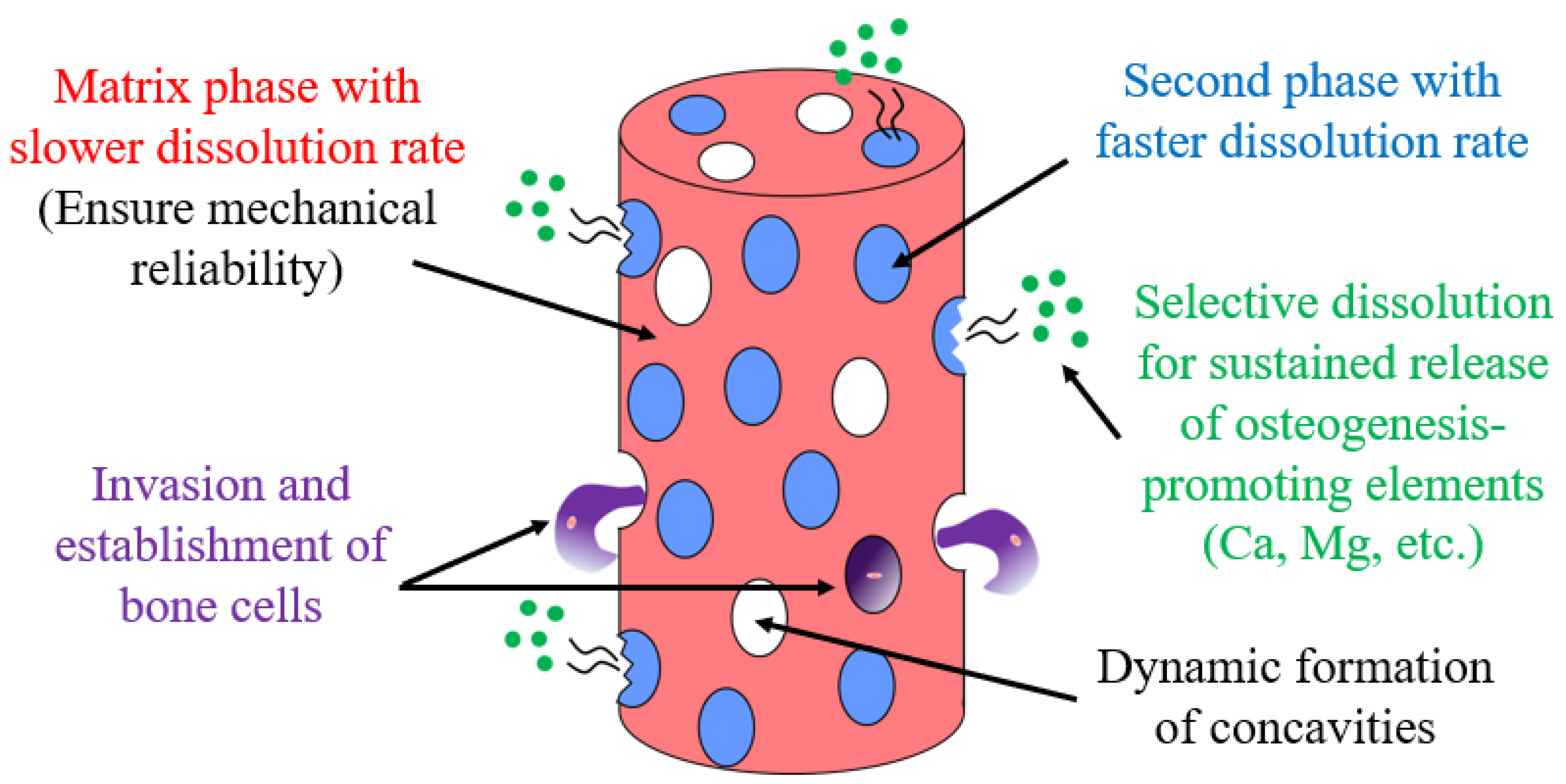
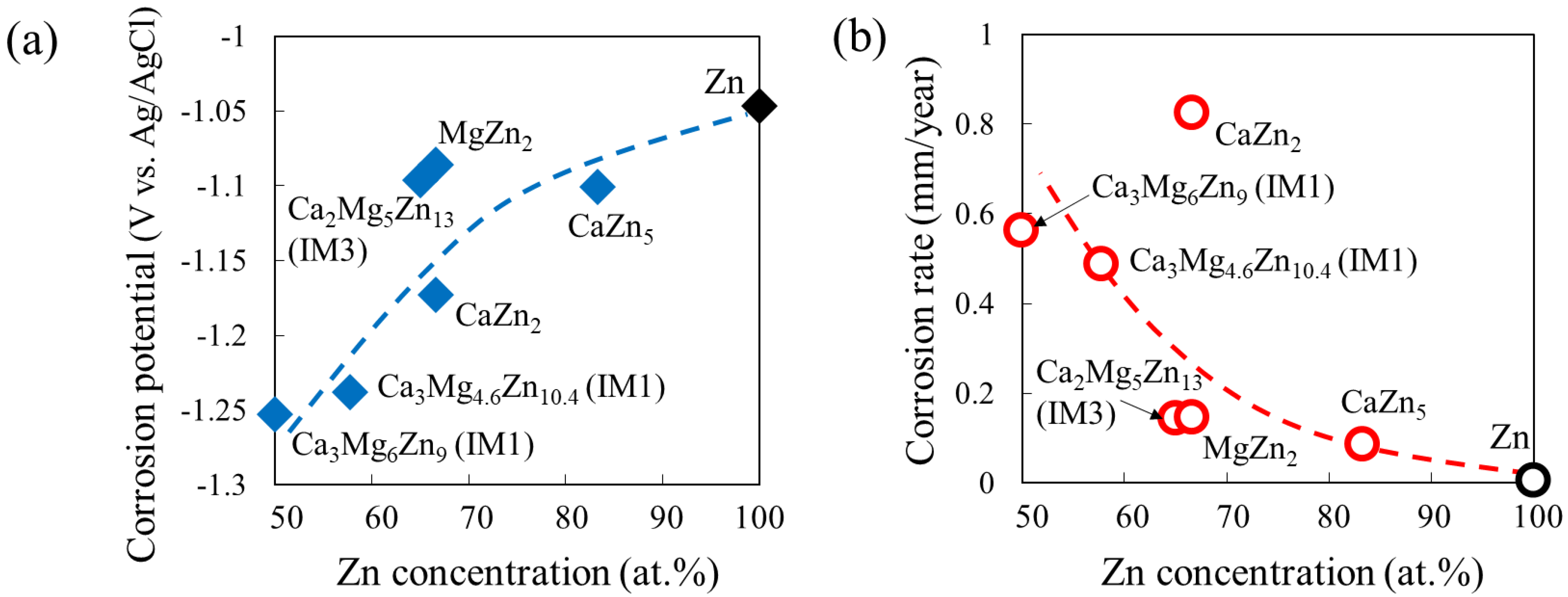
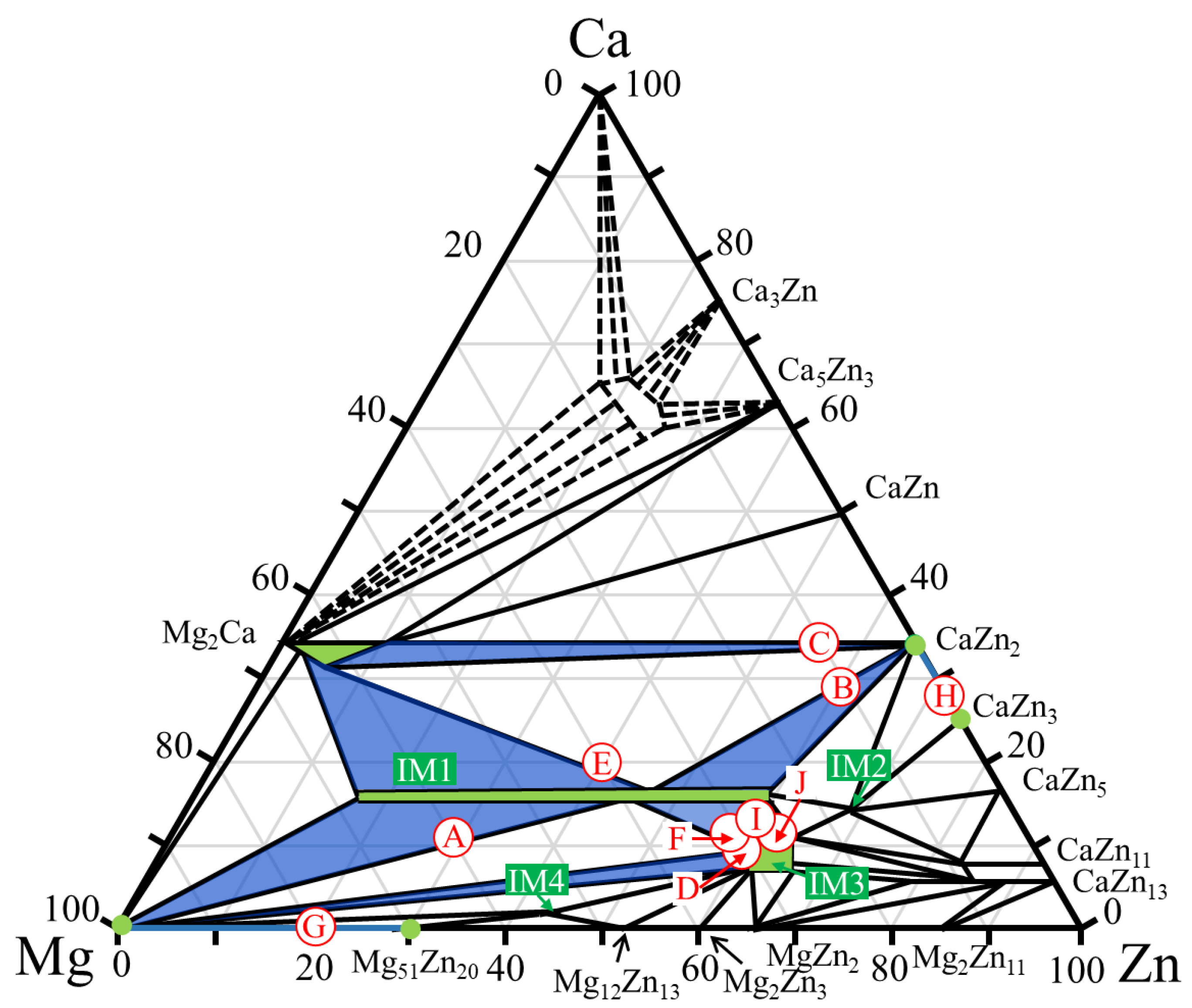
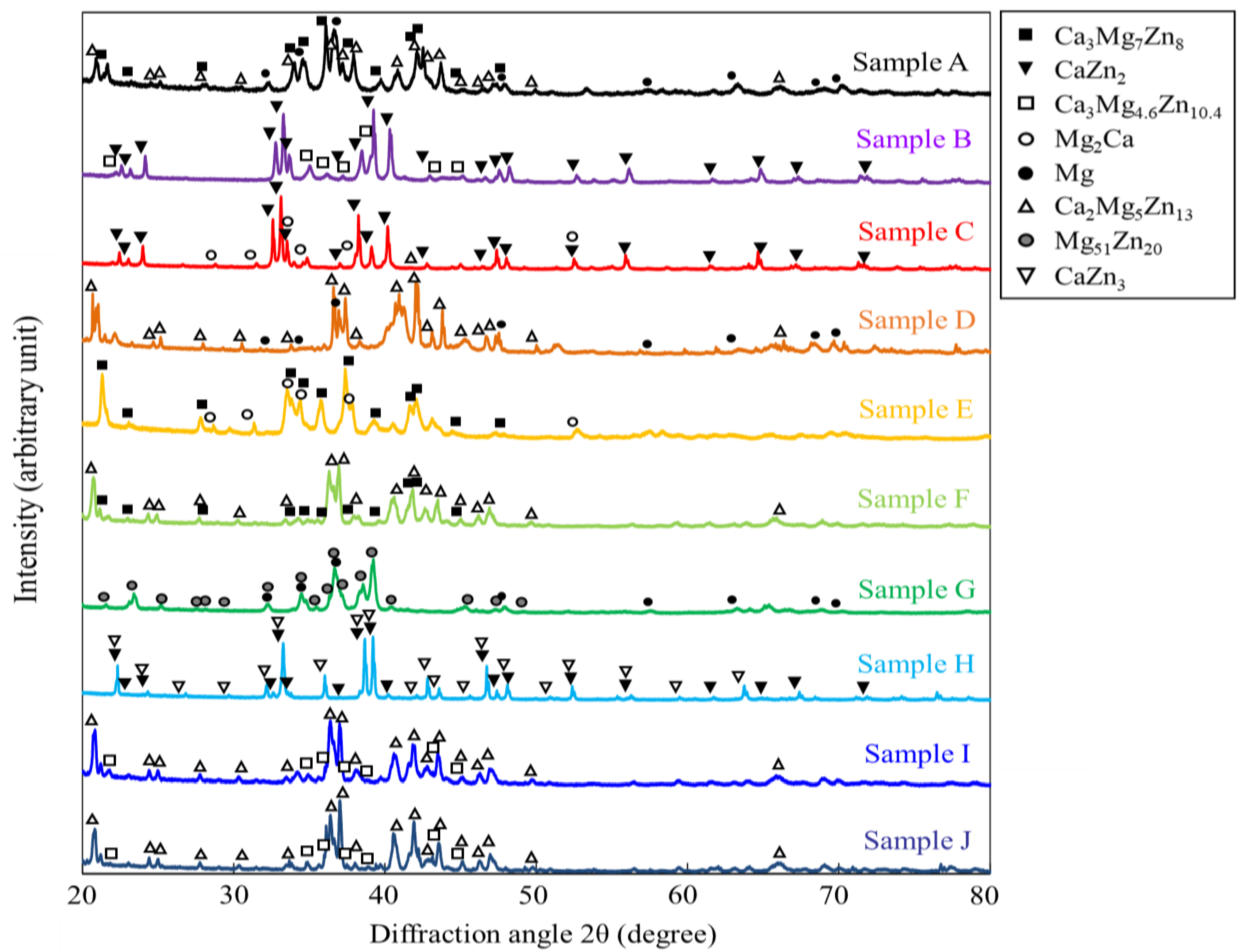

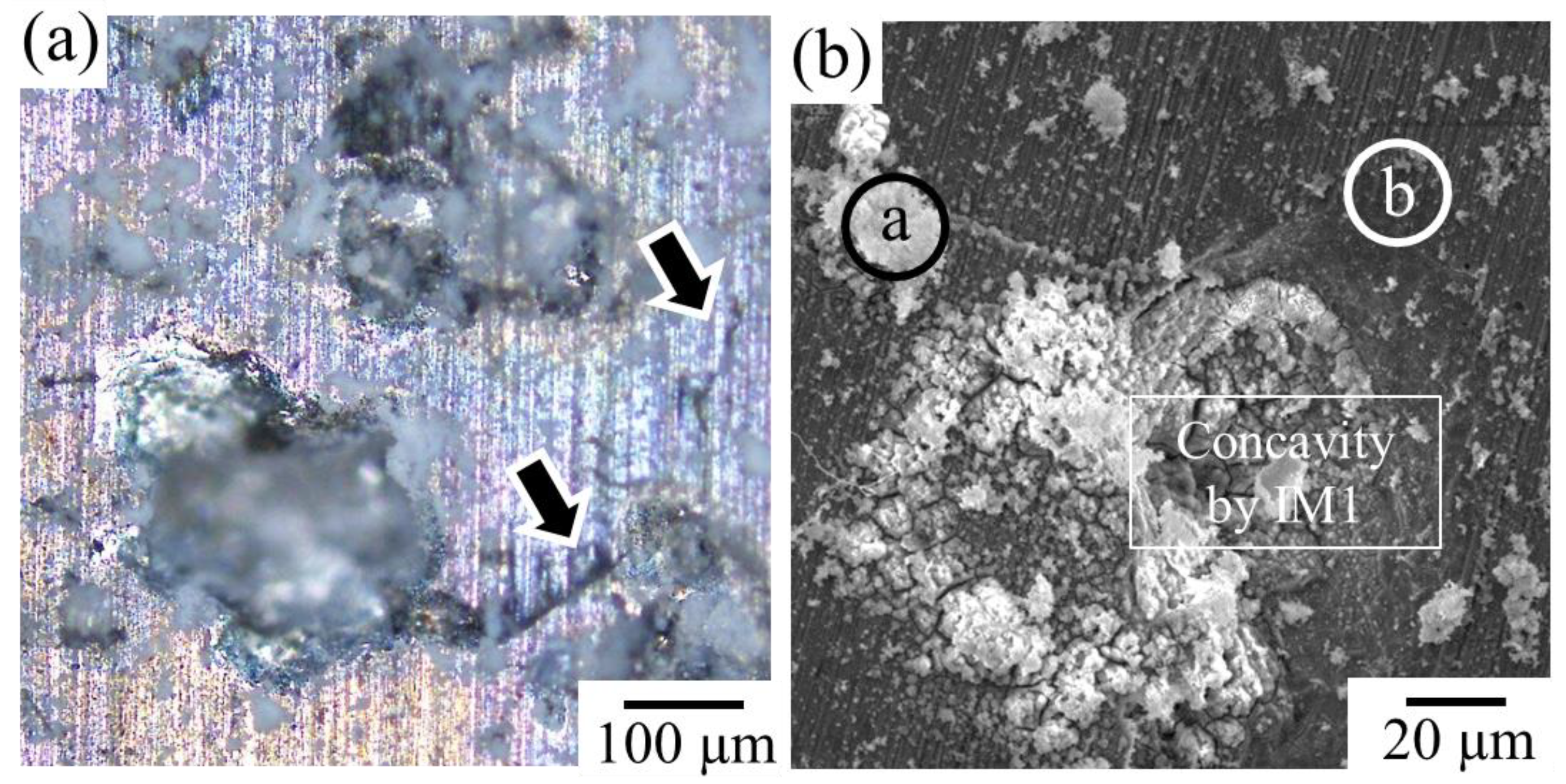
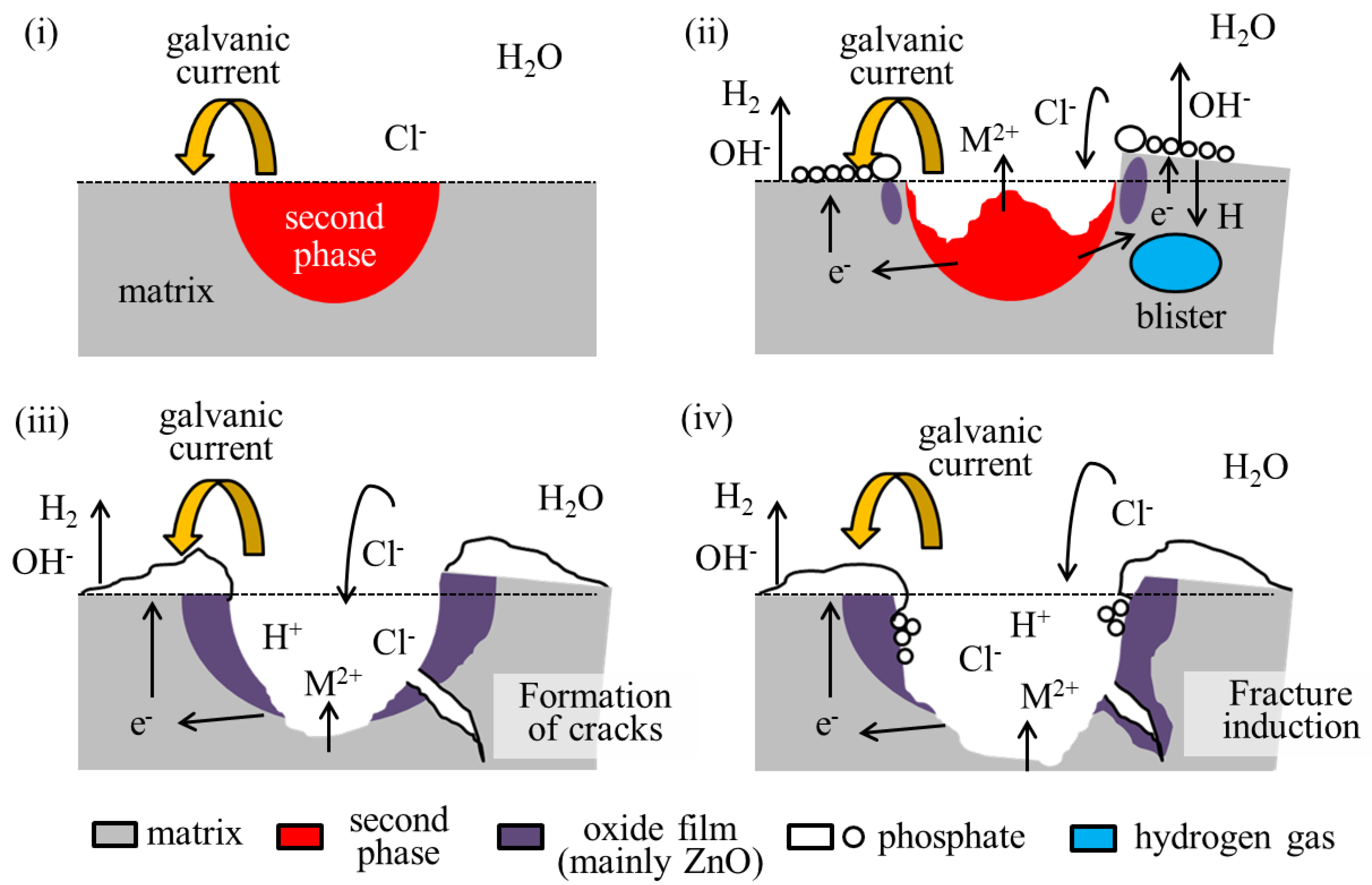
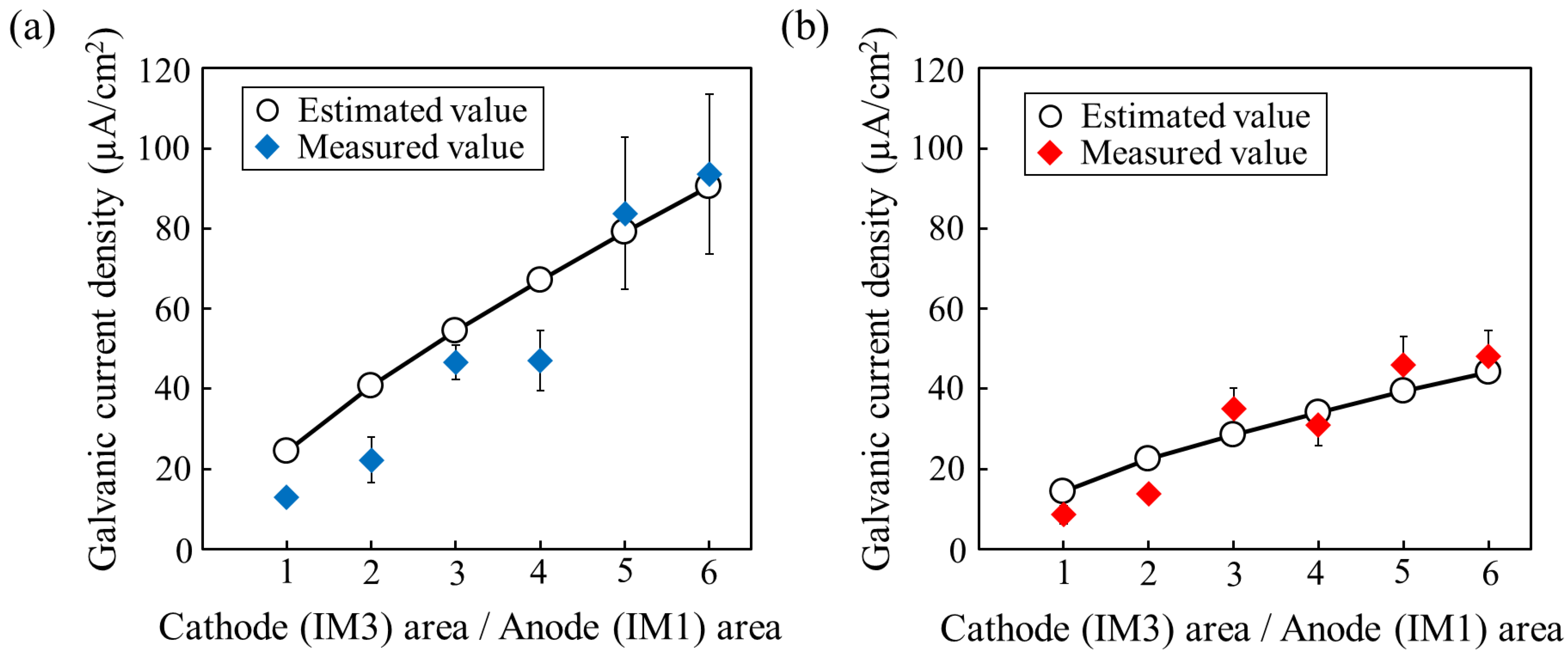


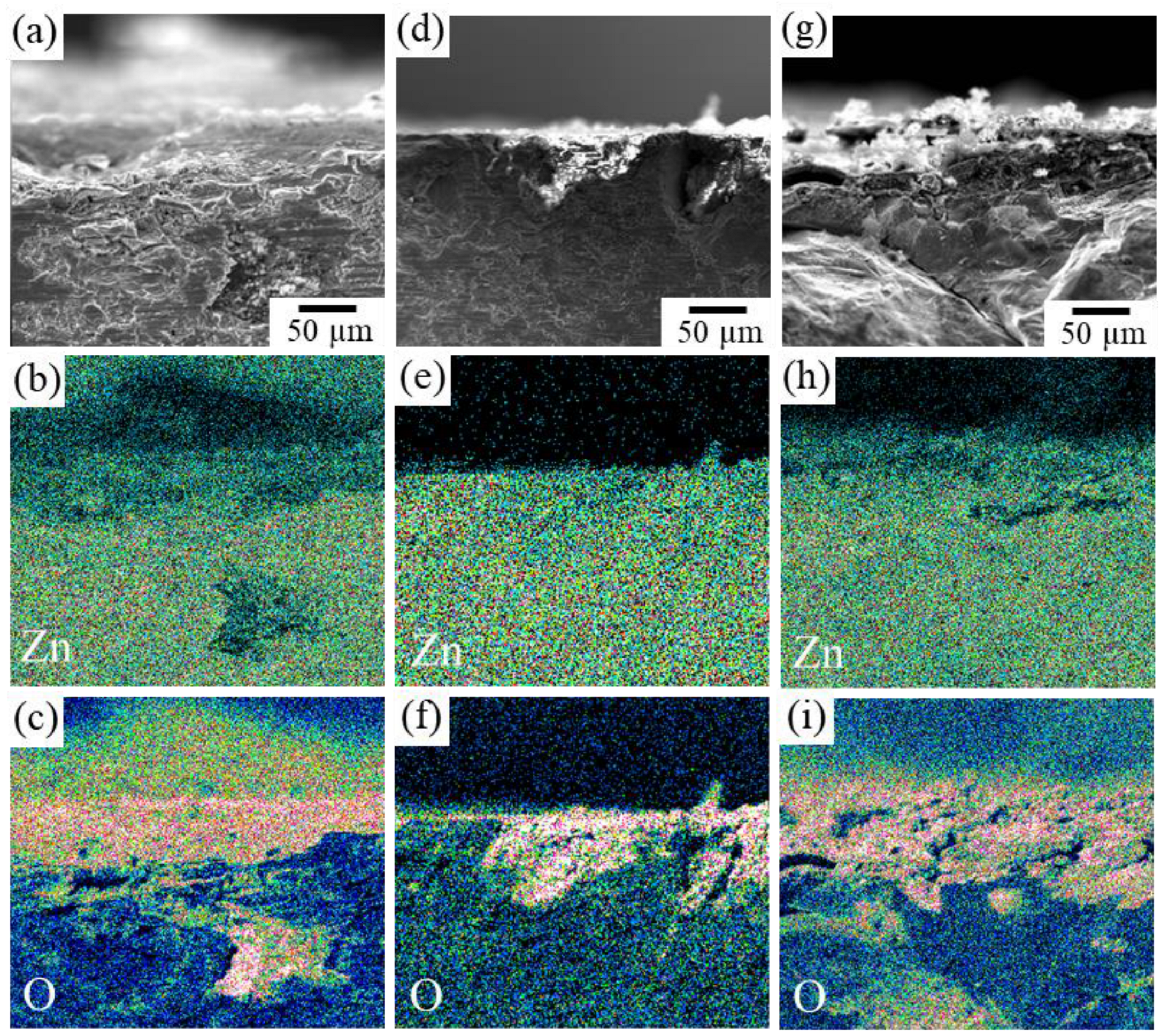
| Sample Name | Alloy Composition (at.%) | Constituent Phase (Noble/Less Noble) |
|---|---|---|
| A | Zn29Mg60Ca11 | IM1 (IM3)/Mg |
| B | Zn60Mg12Ca28 | CaZn2/IM1 |
| C | Zn57Mg10Ca33 | CaZn2/Mg2Ca |
| D | Zn60Mg30Ca10 | IM3/Mg |
| E | Zn40Mg40Ca20 | IM1/Mg2Ca |
| F | Zn59Mg29Ca12 | IM3/IM1 |
| G | Zn20Mg80 | Mg51Zn20/Mg |
| H | Zn72Ca28 | CaZn3/CaZn2 |
| I | Zn61Mg26Ca13 | IM3/IM1 |
| J | Zn63Mg25Ca12 | IM3/IM1 |
| Sample A | Sample B | Sample C | Sample D | ||||||
|---|---|---|---|---|---|---|---|---|---|
| a | b | c | d | e | f | g | h | i | |
| Ca | 14.6 | 0.2 | 9.3 | 34.0 | 18.1 | 27.9 | 32.6 | 10.0 | 0.2 |
| Mg | 42.7 | 97.1 | 28.9 | 0.3 | 24.9 | 0.2 | 49.8 | 28.0 | 93.9 |
| Zn | 42.7 | 2.7 | 61.9 | 65.7 | 57.1 | 71.9 | 17.6 | 62.0 | 5.9 |
| phase | IM1 | α-Mg | IM3 | CaZn2 | IM1 | CaZn2 | Mg2Ca | IM3 | α-Mg |
| Sample E | Sample F | Sample G | Sample H | ||||||
| j | k | l | m | n | o | p | q | ||
| Ca | 13.1 | 30.8 | 11.1 | 15.5 | - | - | 21.2 | 27.4 | |
| Mg | 49.1 | 57.9 | 26.0 | 37.4 | 64.5 | 94.8 | - | - | |
| Zn | 37.8 | 11.3 | 62.9 | 47.1 | 34.5 | 5.2 | 78.8 | 72.6 | |
| phase | IM1 | Mg2Ca | IM3 | IM1 | Mg51Zn20 | α-Mg | CaZn3 | CaZn2 | |
| a | b | |
|---|---|---|
| Ca | 35.7 | 14.0 |
| Mg | 8.7 | 22.8 |
| Zn | 1.9 | 63.2 |
| P | 16.4 | - |
| O | 37.4 | - |
Disclaimer/Publisher’s Note: The statements, opinions and data contained in all publications are solely those of the individual author(s) and contributor(s) and not of MDPI and/or the editor(s). MDPI and/or the editor(s) disclaim responsibility for any injury to people or property resulting from any ideas, methods, instructions or products referred to in the content. |
© 2023 by the authors. Licensee MDPI, Basel, Switzerland. This article is an open access article distributed under the terms and conditions of the Creative Commons Attribution (CC BY) license (https://creativecommons.org/licenses/by/4.0/).
Share and Cite
Hagihara, K.; Shakudo, S.; Tokunaga, T.; Nakano, T. Development of Zn–Mg–Ca Biodegradable Dual-Phase Alloys. Metals 2023, 13, 1095. https://doi.org/10.3390/met13061095
Hagihara K, Shakudo S, Tokunaga T, Nakano T. Development of Zn–Mg–Ca Biodegradable Dual-Phase Alloys. Metals. 2023; 13(6):1095. https://doi.org/10.3390/met13061095
Chicago/Turabian StyleHagihara, Koji, Shuhei Shakudo, Toko Tokunaga, and Takayoshi Nakano. 2023. "Development of Zn–Mg–Ca Biodegradable Dual-Phase Alloys" Metals 13, no. 6: 1095. https://doi.org/10.3390/met13061095
APA StyleHagihara, K., Shakudo, S., Tokunaga, T., & Nakano, T. (2023). Development of Zn–Mg–Ca Biodegradable Dual-Phase Alloys. Metals, 13(6), 1095. https://doi.org/10.3390/met13061095







